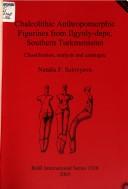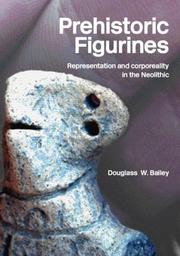| Listing 1 - 10 of 24 | << page >> |
Sort by
|
Book
ISBN: 1789250226 178925020X 9781789250206 9781789250190 1789250196 Year: 2019 Publisher: Oxford : Oxbow Books,
Abstract | Keywords | Export | Availability | Bookmark
 Loading...
Loading...Choose an application
- Reference Manager
- EndNote
- RefWorks (Direct export to RefWorks)
"The Chalcolithic period in Cyprus has been known since Porphyrios Dikaios' excavations at Erimi in the 1930s and through the appearance in the antiquities market of illicitly acquired anthropomorphic cruciform figures, often manufactured from picrolite, a soft blue-green stone. The excavations of the settlement and cemetery at Souskiou Laona reported on in this volume paint a very different picture of life on the island during the late 4th and early 3rd millennia BC. Burial practices at other known sites are generally single inhumations in intramural pit graves, only rarely equipped with artefacts. At Souskiou, multiple inhumations were interred in deep rock-cut tombs clustered in extra-mural cemeteries. Although the sites were also subjected to extensive looting, excavations have revealed complex multi-stage burial practices with arrangements of disarticulated and articulated burials accompanied by a rich variety of grave goods. Chief among these are a multitude of cruciform figurines and pendants. This unusual treatment of the dead, which has not been recorded elsewhere in Cyprus, shifts the focus from the individual to the communal, and provides evidence for significant changes involving kinship group links to common ancestors. Excavations at the Laona settlement have furnished evidence suggesting that it functioned as a specialised centre for the procurement and manufacture of picrolite during its early phase. The subsequent decline of picrolite production and the earliest known occurrence of new types of ornaments, such as faience beads and copper spiral pendants, attest to important changes involving the transformation of personal and social identities during the first centuries of the 3rd millennium BC, a topic that forms a central theme of this final report on the site"--
Figurines, Prehistoric --- Prehistoric figurines --- Statuettes, Prehistoric --- Sculpture, Prehistoric

ISBN: 1841716820 Year: 2005 Publisher: Oxford : Archaeopress,
Abstract | Keywords | Export | Availability | Bookmark
 Loading...
Loading...Choose an application
- Reference Manager
- EndNote
- RefWorks (Direct export to RefWorks)
Accounts --- Copper age --- Egyptian language --- Excavations (Archaeology) --- Figurines, Prehistoric
Book
ISBN: 3854602448 Year: 2008 Publisher: Sankt Pölten : Niederösterreichischen Landesmuseums,
Abstract | Keywords | Export | Availability | Bookmark
 Loading...
Loading...Choose an application
- Reference Manager
- EndNote
- RefWorks (Direct export to RefWorks)
Gravettian culture --- Figurines, Prehistoric --- Gravettien --- Figurines préhistoriques

ISBN: 041533151X 0415331528 Year: 2005 Publisher: London ; New York Routledge
Abstract | Keywords | Export | Availability | Bookmark
 Loading...
Loading...Choose an application
- Reference Manager
- EndNote
- RefWorks (Direct export to RefWorks)
Figurines, Prehistoric --- Figurines préhistoriques --- Balkan Peninsula --- Balkans --- Antiquities. --- Antiquités --- Figurines préhistoriques --- Antiquités

ISBN: 1134323298 1134323301 1280243880 9786610243884 0203392450 9780203392454 9780415331517 041533151X 9780415331524 0415331528 6610243883 041533151X 0415331528 9781134323302 9781134323258 1134323255 9781134323296 Year: 2005 Publisher: London ; New York : Routledge,
Abstract | Keywords | Export | Availability | Bookmark
 Loading...
Loading...Choose an application
- Reference Manager
- EndNote
- RefWorks (Direct export to RefWorks)
Fully illustrated, Prehistoric Figurines brings a radical new approach to one of the most exciting, but poorly understood artefacts from our prehistoric past. Studying the interpretation of prehistoric figurines from Neolithic southeast Europe, Bailey introduces recent developments from the fields of visual culture studies and cultural anthropology, and investigates the ways in which representations of human bodies were used by the pre-historic people to understand their own identities, to negotiate relationships and to make subtle political points.Bailey examines four critic
Figurines, Prehistoric --- Prehistoric figurines --- Statuettes, Prehistoric --- Sculpture, Prehistoric --- Balkan Peninsula --- Antiquities.
Book
ISBN: 131651093X 1009039075 1009041460 1009041266 Year: 2022 Publisher: Cambridge : Cambridge University Press,
Abstract | Keywords | Export | Availability | Bookmark
 Loading...
Loading...Choose an application
- Reference Manager
- EndNote
- RefWorks (Direct export to RefWorks)
Why did the male nude come to occupy such an important place in ancient Greek culture? Despite extended debate, the answer to this question remains obscure. In this book, Sarah Murray demonstrates that evidence from the Early Iron Age Aegean has much to add to the discussion. Her research shows that aesthetics and practices involving male nudity in the Aegean had a complicated origin in prehistory. Murray offers a close analysis of the earliest male nudes from the late Bronze and Early Iron Ages, which mostly take the form of small bronze votive figurines deposited in rural sanctuaries. Datable to the end of the second millennium BCE, these figurines, she argues, enlighten the ritual and material contexts in which nude athletics originated, complicating the rationalizing accounts present in the earliest textual evidence for such practices. Murray's book breaks new ground by reconstructing a scenario for the ritual and ideological origins of nudity in Greek art and culture.
Male nude in art. --- Bronze figurines, Renaissance. --- Bronze figurines, Prehistoric --- Votive offerings, Prehistoric --- Iron age
Book
ISBN: 9781784917784 Year: 2018 Publisher: Oxford : Archaeopress Publishing Ltd,
Abstract | Keywords | Export | Availability | Bookmark
 Loading...
Loading...Choose an application
- Reference Manager
- EndNote
- RefWorks (Direct export to RefWorks)
Antiquities, Prehistoric --- Figurines, Prehistoric --- Grave goods --- Funeral rites and ceremonies, Ancient
Book
ISBN: 9789608533288 9608533287 Year: 2018 Publisher: Athens : University of the Aegean, Laboratory of Environmental Archaeology,
Abstract | Keywords | Export | Availability | Bookmark
 Loading...
Loading...Choose an application
- Reference Manager
- EndNote
- RefWorks (Direct export to RefWorks)
Excavations (Archaeology) --- Neolithic period --- Material culture --- Pottery, Prehistoric --- Tools, Prehistoric --- Figurines, Prehistoric
Book
ISBN: 9781604976748 Year: 2010 Publisher: Amherst Cambria
Abstract | Keywords | Export | Availability | Bookmark
 Loading...
Loading...Choose an application
- Reference Manager
- EndNote
- RefWorks (Direct export to RefWorks)
Fertility, Human, in art --- Figurines, Prehistoric --- Goddesses, Prehistoric --- Neolithic period --- Sex role --- Women, Prehistoric --- History
Book
ISBN: 0817382380 9780817382384 0817315950 9780817315955 0817354654 9780817354657 9780817315955 9780817354657 Year: 2009 Publisher: Tuscaloosa University of Alabama Press
Abstract | Keywords | Export | Availability | Bookmark
 Loading...
Loading...Choose an application
- Reference Manager
- EndNote
- RefWorks (Direct export to RefWorks)
When European explorers began their initial forays into southeastern North America in the 16th and 17th centuries they encountered what they called temples and shrines of native peoples, often decorated with idols in human form made of wood, pottery, or stone. The idols were fascinating to write about, but having no value to explorers searching for gold or land, there are no records of these idols being transported to the Old World, and mention of them seems to cease about the 1700's. However, with the settling of the fledgling United States in the 1800's, farming colonists began
Mississippian culture --- Figurines, Prehistoric --- Stone carving --- Tennessee River Valley --- Cumberland River Valley (Ky. and Tenn.) --- Antiquities.
| Listing 1 - 10 of 24 | << page >> |
Sort by
|

 Search
Search Feedback
Feedback About UniCat
About UniCat  Help
Help News
News